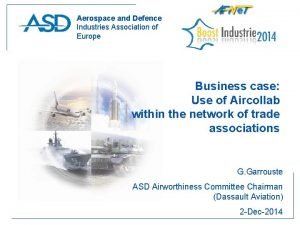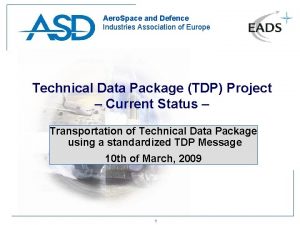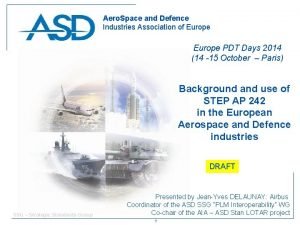Aero Space and Defence Industries Association of Europe






- Slides: 6

Aero. Space and Defence Industries Association of Europe Proper distribution of general/technical requirements between hard and soft laws Kyle Martin Airworthiness Manager EASA Certification Workshop 30 th January 2014, Cologne 1

Reminder: Structure of Common Rules in the field of Civil Aviation (1/2) (Co-decision European Council & European Parliament) • Distribution of responsibilities between EC, MS, EASA Regulations EASA, SES • Essential requirements • What stakeholders have to do. Implementing Rules • Rules issued by the European Commission Soft Law • How stakeholders should Acceptable Means of Compliance Guidance Material Certification Specifications Slide 2 do what they have to do. • Rules issued by the EASA

Reminder: Structure of Common Rules in the field of Civil Aviation (2/2) (Co-decision European Council & European Parliament) Regulations EASA, SES The European Commission has the legislative initiative. Several years are necessary for changes / improvements Implementing Rules Soft Law Acceptable Means of Compliance Guidance Material Certification Specifications Slide 3 EASA has the authority to allow deviations from / adjustments to Soft Laws ONLY

Industry Concerns The use of detailed technical details in ‘hard’ law such as the Basic Regulation, Part 21, EU-OPS, etc. is a concern for the industry for many reasons: Technology: q Can lead to unintended consequences and in some cases preclude the adoption of new technologies that would improve safety. Applicability: q Rules in Hard law need to be equally applicable for an Airbus A 380 as a Cessna 172 Compliance: q Increased burden for industry and regulators in demonstrating compliance. Slide 4

Selected Examples Future Aviation Occurrence Reporting: 72 hour rule, 3 -month reporting, etc EU-OPS: q Kind of altimeter (radio versus baro) specified for low visibility approaches (SPA. LVO. 110). q Minima for low visibility approaches (SPA. LVO. 110). q Detailed specification of seat belts (CAT. IDE. H. 205). Part 21: q Minimum of 300 hours flight for endurance testing with new engine types (21. A. 35) q No possibility to manage a change to Airworthiness Limitations Section as a change to the Type Design (with major/minor classification, use of associated privileges) Slide 5

Way forward Define formal guidance when developing a new rule or revising an existing one: q The content of Implementing Rules should be limited to: o o o Defining the safety objectives Applicability Deadlines Performance-basis or risk-basis Be non-prescriptive (technologies, methods, etc. ) q Leave all technical criteria and acceptable means of compliance or guidance to be addressed in soft laws (Certification Specifications (CS), AMC, GM) which are issued, maintained and administered by the EASA. Allow the EASA to use the flexibility provisions which are offered to the Members States. Slide 6











